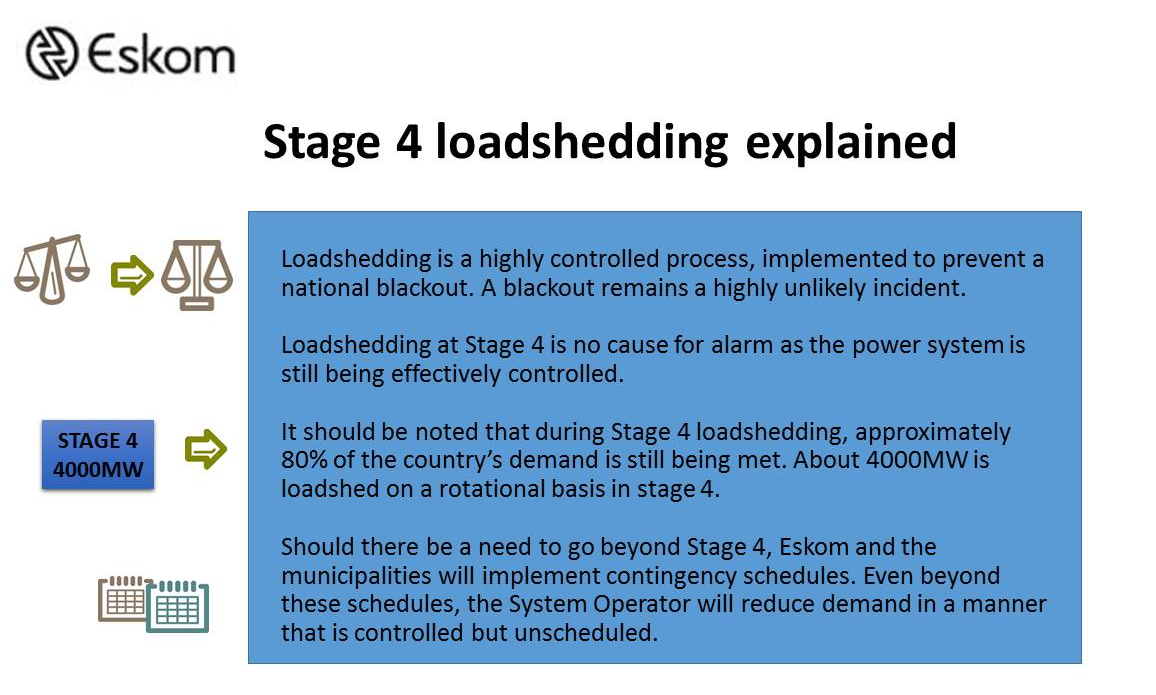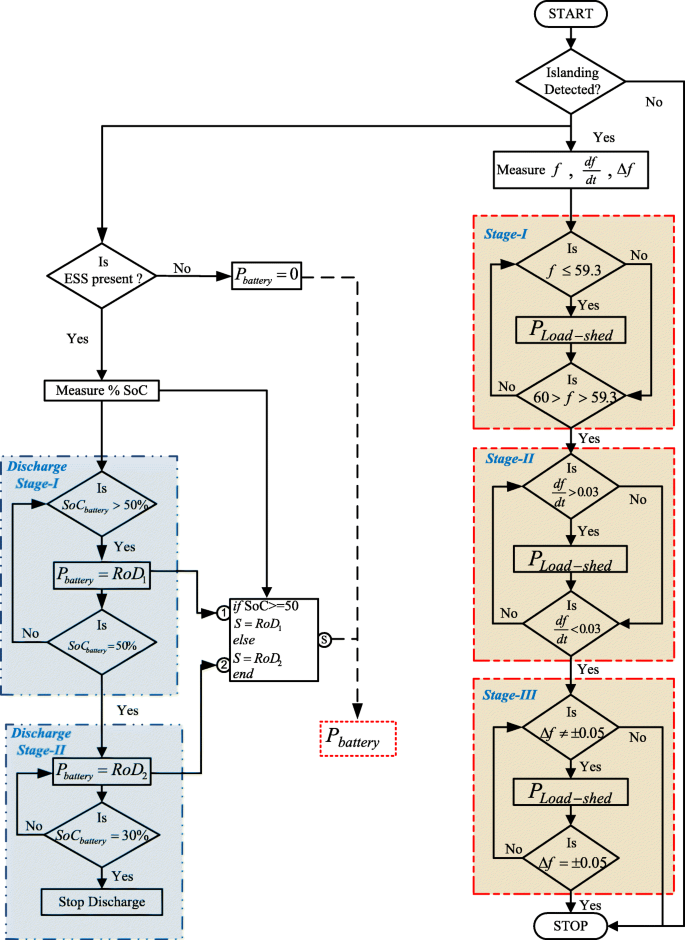Different Stages of Load Shedding Explained
When Stage 2 load shedding is implemented the load shedding schedules will be implemented in full. Ekurhuleni spokesman Themba Gadebe explained.

What Stage 8 Load Shedding Means For South Africa
Ekurhuleni areas are only covered under blocks 17 18 19 and 20 as indicated on Eskoms load shedding schedule.
. And the last group C has electricity supply for. Customers are encouraged to go through the four blocks to identify under which block their areas fall including the time they. Each area that will be affected based on the relevant stage is.
Stage 6 6000 megawatts Shed. Due to a continued loss of generating. Stage 1 is implemented when Eskom requests for a load shedding range from 10MW to 300MW.
Will double the frequency of Stage 1 which means you will be scheduled for load. In this stage areas to be affected are divided into two equal load sizes to accommodate Eskoms load reduction needs. To explain it as simply as possible.
Ekurhuleni spokesman Themba Gadebe explained. Stage 2 will double the frequency of Stage 1 which means you will be scheduled for load shedding 6. If there are eight areas in a block to be affected areas all eight areas will be affected Themba added.
Loadshedding powercuts. In this stage areas to be affected are divided into two equal load sizes to accommodate Eskoms load reduction needs. This is what the different stages of load shedding means.
Load Shedding Explained Super User Service Delivery 10 October 2020 Hits. In the dynamic load shedding the amount of load to be disconnected at each shedding stage is dynamically selected based on the system frequency the rate of change in the frequency the voltage and the severity of the disturbances. Jaco Human Less than a minute.
The frequency of load shedding increases as higher Stages are used. The image below will explain how to see when you will be load shed and for how long depending on the stage implemented. On Friday 25 January 2019 thousands of Victorian households were left without power for several hours during a load shedding event which is when power is cut to small parts of the electricity grid for a short time to avoid wide scale blackouts.
Stage 5 5000 megawatts Shed. The second group B has electricity supply for 8 hours from 1200 noon to 800 pm. When there is not enough electricity available to meet the demand from all Eskom customers it thus.
This chapter is intended to give the reader a better understanding of the load shedding methods currently applied and proposed over the years. Stage 4 4000 megawatts Shed. Stage one is implemented when Eskom requests a loadshedding range from between 10MW to 300MW.
There are eight stages of load shedding. In this stage areas to be affected are divided into two equal load sizes to accommodate Eskoms load reduction needs. Stage 8 8000 megawatts Shed.
Loadshedding is generally scheduled for a duration of 2 4 hours depending on the schedule for your area. Share on Facebook Load shedding is a controlled way to make sure that the national power grid remains stable and does not lead to countrywide total blackout. Stage 1 requires the least amount of load shedding three times over a four day period for two hours at a time or three times over an eight-day period for four hours at a time.
Ekurhuleni spokesman Themba Gadebe explained. Each stage allows for a certain amount of electricity to be shed from the general supply. INTERPRETING ESKOM LOAD-SHEDDING STAGES Most of the information below is a summary of that contained on the wwweskomcoza webpage.
But exactly how does the different load shedding stages 1 2 and 3 work. Understanding the different load-shedding stages and how to prepare for them is vital to helping households cope with the impact of the power cuts. Eskoms Stage 3 load shedding is divided into a number of blocks for seven days of the week.
Stage 1 is implemented when Eskom requests for a load shedding range from 10MW to 300MW. On the first day of the program the first group A has electricity supply for 8 hours from 400 am to 1200 noon. This is a strong indicator of the dire situation Eskom finds.
Stage 7 7000 megawatts Shed. Most buildings including data centers purchase electrical power from a utility provider. In order to see which stage Eskom has implemented visit the Eskom load shedding page.
What all the columns really mean. Stage 3 is implemented when Eskoms grid is under severe pressure. As a result they announced they would need to implement a blackout schedule that they dubbed load shedding.
Stage 3 3000 megawatts Shed. The only difference between the stages is that Eskom will load shed more areas the higher the stage. In this stage areas to be affected are divided into two equal load sizes to accommodate Eskom load reduction needs Gadebe said.
The term load shedding first started dominating the South African lexicon in 2007 when the countrys national electricity utility Eskom announced that it was unable to supply power to the entire country at the same time. To clarity this each load-shedding slot on the schedule is two and a half hours long with consecutive slots overlapping by half an hour. If the metro schedule has eight areas in a block to be affected only four of the eight areas may be.
The higher the stage the greater the quantity of electricity that needs to be shed which means that load. Requires up to 1000 MW of electricity to be shed and can be implemented three times over a four-day period for two hours at a time or three times over an eight-day period for 4 hours at a time. Stage 1 is implemented when Eskom requests for a load shedding range from 10MW to 300MW.
And until this capacity is met the risk of load shedding remains. But exactly how does the different load shedding stages 1 2 and 3 work. Which effectively means if you do the math stage eight has the potential of leaving affected consumers powerless for up to 175 hours.
The importance of operation of islanded distribution networks was discussed. Load shedding loadshedding is a way to distribute demand for electrical power across multiple power sources. In other words the amount of a load shedding block is a function of the magnitude of the power imbalance.
Tuesday 9 December 2014 - 120pm When Eskom implements load shedding it does so in different stages on a rotational basis from 2-4 hours to protect the. But exactly how does the different load shedding stages 1 2 and 3 work. Stage 3 is completely out of EMM control and.
Capacity Stage 2 load shedding will be implemented from 1700 2200. Load shedding is used to relieve stress on a primary energy source when demand for electricity is greater than the primary power source can supply. A day in the new model starts from 400 am the first day and ends at 400 am the next day.
However it is assumed that the reader is familiar with basic power system engineering. LOAD SHEDDING WILL BE USED UNDER EMERGENCY CONDITIONS FOR LIMITED PERIODS ONLY Load-shedding is. We take a closer look at what caused this and explore the important role of the Market Operator.
The stages are on a sliding scale with Stage 1. Load shedding stages what do they mean.

Explainer Stage 4 Load Shedding And How It Affects You Enca

The Effects Of Loadshedding And How We Can All Work Together Atlas Security
Flow Chart Of Protective Relay Setting And Load Shedding Scheme Design Download Scientific Diagram

Load Shedding Strategy Coordinated With Storage Device And D Statcom To Enhance The Microgrid Stability Springerlink
No comments for "Different Stages of Load Shedding Explained"
Post a Comment